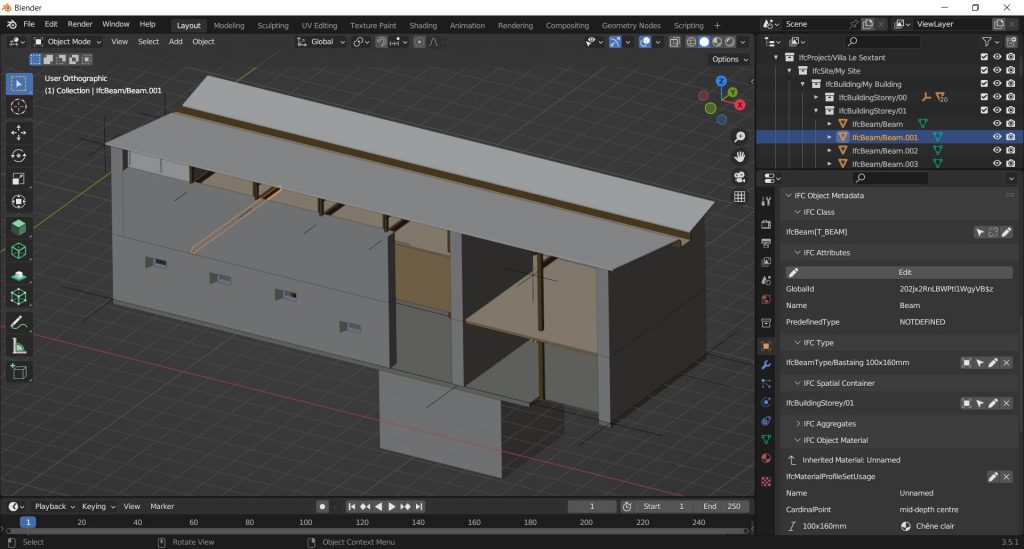
BlenderBIM and IFC.js are revolutionizing BIM by offering open-source tools and establishing the open standard IFC as the native working format for architects and engineers
What is the project about?
Building Information Modeling (BIM) is a methodology that combines geometric representations and metadata of construction projects. Both can be transmitted via the open standard known as the Industry Foundation Classes (IFC), which was created by buildingSMART to support an open approach of BIM. Any experts in the architectural, engineering, and construction (AEC) sector can exchange or submit work using the IFC schema. It offers a universal, open vocabulary for describing everything, from a building’s geometry to its thermal characteristics. For construction projects, the format offers interoperable and long-term accessible data and is vendor-neutral.
Currently, the main step in working with IFC is converting digital models into .ifc file formats, which can be exported from many software packages like Revit or Archicad. With the help of the file format, BIM models—complete with 3D geometry and metadata—can be easily shared with partners, such as an economist who has to keep expenses under control or a client—such as a government agency—that wants to employ a digital twin for maintenance. The Laboratory of Numeric Cultures for Architectural Projects (CNPA) is investigating BlenderBIM and IFC.js to offer open-source alternatives. BlenderBIM is an add-on based on the IfcOpenShell project that incorporates IFC into the Blender modeling software, whereas IFC.js is a library of JavaScript code that enables the development of BIM environments on the web.
Being open-source, these projects offer open access to use as well as the ability to adapt and advance them, which can enhance the AEC industry’s digital workflows. Furthermore, they establish Native IFC, a new paradigm which makes users natively generate and edit models in the IFC format, traditionally intended just for exchange. This frees the file from the tool you use and makes it possible to collaborate and keep possession of your file though time without depending on a specific piece of software. Also, this opens the door for Git, a workflow for collaboration in the AEC sector.
We are using these projects in two different ways :
Regarding IFC.js, we developed a web-based gallery and BIM viewer for the stereotomy course pavilion projects, designed parametrically by Bachelor students on Topsolid, a CAD/CAM software. It shows that they can share their architectural work in a BIM manner, integrating 3D and data with a simple web link and through an open format. We have explored further functionality for our BIM teaching unit, taught by my colleagues Elise Hautecoeur and Mohammed Alem, through a collaboration with the EPFL-based start-up Uzufly. They have developed an IFC.js x Cesium web platform where we can upload the BIM model into a photorealistic GIS environment they have surveyed.
On the other hand, regarding BlenderBIM, we are writing a tutorial on the modeling of Le Corbusier’s Villa Le Sextant. While giving students an open-source alternative to our other tutorials on proprietary software, writing such an exercise also acts as a contribution to the community by testing, documenting and suggesting improvements.
To showcase all these great emerging open-source initiatives in the AEC, we organized an Open Source for Architects Conference, at the EPFL Campus and online on March 16, 2023. The recordings are available on the EPFL mediaspace here.
Credits: Uzufly
Who benefits from it?
An open-source approach of the IFC open standard benefits all AEC actors who have opted for a BIM methodology in their daily work. Furthermore, the promotion of these alternatives should not be seen as a crusade against proprietary software. Open Source is key to innovation, it brings ideas and development that commercial editors are free to use too, as well as the end users. So, we believe that proprietary softwares will always have a place in our processes, by offering us the appropriate tools and support for specific tasks, but not by locking us into data formats that make architectural or engineering offices hostage to their licenses.
IFC.js and BlenderBIM already have enthusiastic communities of professionals using and contributing to them. You can find support for IFC.js on their Discord, and for BlenderBIM on the forum of OSArch, the community that promotes Free Software and Open Source in architecture. In Switzerland, we should also mention an initiative called opensource.construction, which focuses particularly on bringing such methods to the specific context of our country; we welcome this necessary effort, because in the end, outside the computer, construction will always be rooted into the products, laws or skills of the specific place where it is built.
By the way, large Swiss entities such as the Canton of Geneva and the Swiss Federal Railways (SBB) rely on IFC to establish their BIM roadmap. We believe that it is therefore our duty to teach future architects and engineers at EPFL to master this open standard.

How did you make it Open?
CNPA is developing two open source interoperability tools between projects and fabrication: Rhino.Inside.TopSolid & the Speckle Connector for TopSolid.
https://www.epfl.ch/schools/enac/speckle-topsolid/
As far as native IFC, we do not create tools, but we explore, test and teach them. What we make public is the access to the code of our web developments and the documentation we create about the tools. Everything is available on our Github :
https://enac-cnpa.github.io/IFCjs-Stereotomie/
https://enac-cnpa.github.io/BlenderBIM-Tutoriel-Villa-Le-Sextant/1_introduction.html
Contact: Raphaël Vouilloz